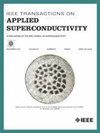Two-Dimensional Kinetic Simulation of the Post-Arc Plasma Dissipation Process of Vacuum Circuit Breaker Influenced by Transverse Magnetic Field
IF 1.7
3区 物理与天体物理
Q3 ENGINEERING, ELECTRICAL & ELECTRONIC
引用次数: 0
Abstract
In this paper, the influence of the transverse magnetic field (TMF) on the post-arc residual plasma dissipation process of vacuum circuit breaker (VCB) is investigated by simulation. A two-dimensional (2D) particle-in-cell (PIC)/ Monte-Carlo collisional (MCC) model of the post-arc plasma dissipation process is established. Firstly, the influences of the TMF on the plasma motion are analyzed. The results indicate that the TMF enhances the ion velocity, thereby facilitating the plasma dissipation. In addition, the model was improved by considering the particle collision process. It was found that the TMF increases collisions and produces more charged particles, which hinders plasma dissipation. Finally, as the TMF affects the movement and collisions of particles, the time for the plasma dissipation initially decreases, then rises as the TMF increases from 0 mT to 400 mT. The minimum dissipation time occurs at 100 mT, with Cu + taking 1.47 µs and electrons taking 1.14 µs. This work could help to improve the breaking ability of the VCB.受横向磁场影响的真空断路器后电弧等离子体耗散过程的二维动力学模拟
本文通过仿真研究了横向磁场(TMF)对真空断路器(VCB)弧后残余等离子体耗散过程的影响。建立了弧后等离子体耗散过程的二维(2D)粒子入胞(PIC)/蒙特卡洛碰撞(MCC)模型。首先,分析了 TMF 对等离子体运动的影响。结果表明,TMF 增强了离子速度,从而促进了等离子体耗散。此外,还通过考虑粒子碰撞过程对模型进行了改进。结果发现,TMF 增加了碰撞,产生了更多带电粒子,从而阻碍了等离子体的耗散。最后,由于 TMF 会影响粒子的运动和碰撞,等离子体耗散的时间最初会减少,然后随着 TMF 从 0 mT 增加到 400 mT 而增加。最短耗散时间出现在 100 mT,Cu+耗时 1.47 µs,电子耗时 1.14 µs。这项工作有助于提高 VCB 的击穿能力。
本文章由计算机程序翻译,如有差异,请以英文原文为准。
求助全文
约1分钟内获得全文
求助全文
来源期刊

IEEE Transactions on Applied Superconductivity
工程技术-工程:电子与电气
CiteScore
3.50
自引率
33.30%
发文量
650
审稿时长
2.3 months
期刊介绍:
IEEE Transactions on Applied Superconductivity (TAS) contains articles on the applications of superconductivity and other relevant technology. Electronic applications include analog and digital circuits employing thin films and active devices such as Josephson junctions. Large scale applications include magnets for power applications such as motors and generators, for magnetic resonance, for accelerators, and cable applications such as power transmission.
 求助内容:
求助内容: 应助结果提醒方式:
应助结果提醒方式:


